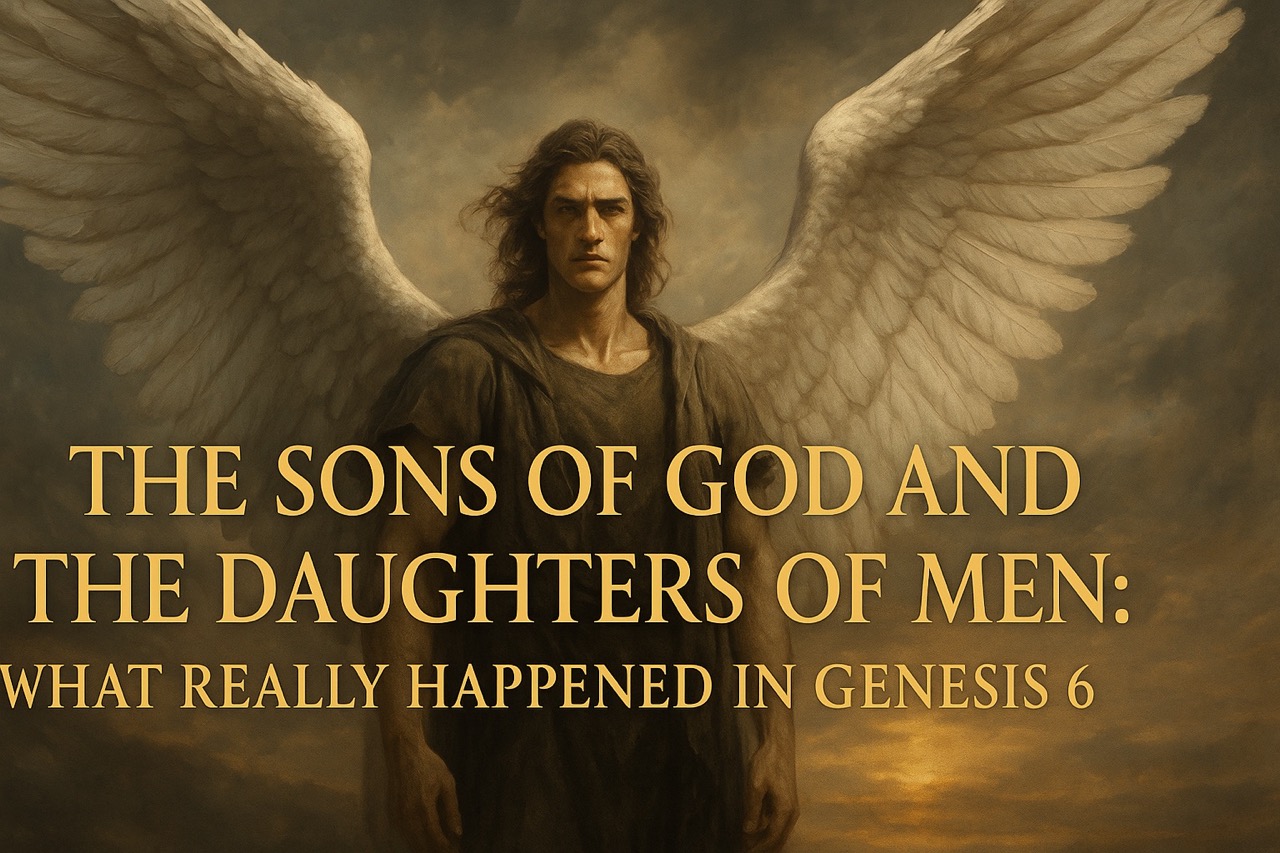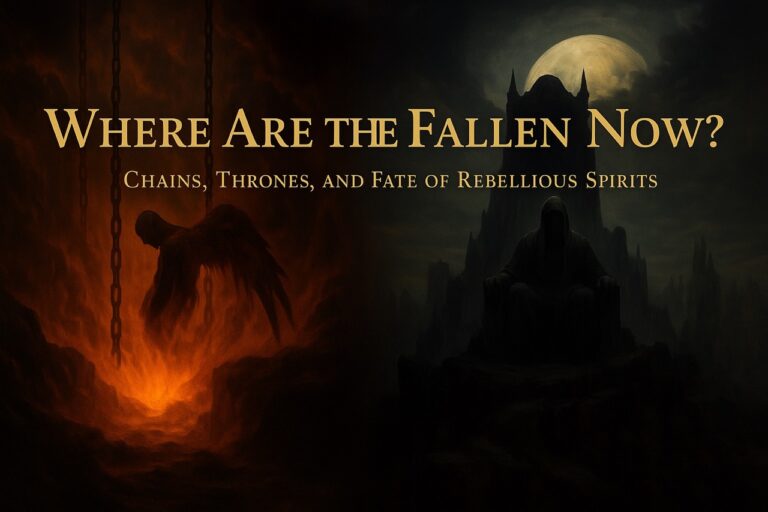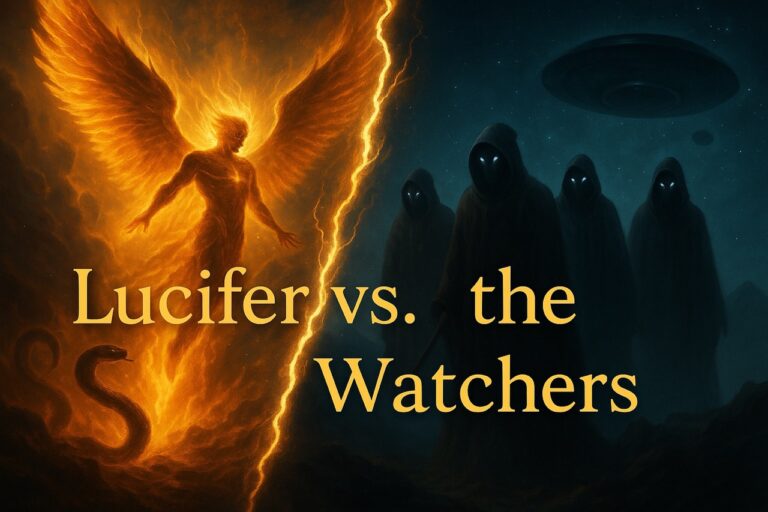The mystery of the sons of God and daughters of men is one of the Bible’s oldest and most debated passages. Found in Genesis 6:1–4, it describes a brief but explosive moment in early human history — when divine beings descended, took human women as wives, and produced offspring known as the Nephilim.
Before the stormclouds gathered over Noah’s age…
Before giants roamed the earth…
There was a union not meant to be.
Heaven touched earth — but not in blessing.
And the world was never the same again.
This wasn’t just moral failure — it was spiritual rebellion. The sons of God crossed boundaries God never intended to be crossed. The result was a corruption so deep that the Creator Himself said He was grieved He had made mankind.
“The LORD saw that the wickedness of man was great in the earth… and the LORD regretted that he had made man on the earth, and it grieved him to his heart.” (Genesis 6:5–6)
But who exactly were these “sons of God”?
- Were they fallen angels?
- Was it simply the mixing of righteous and unrighteous bloodlines?
- And how did this mysterious act lead to the rise of giants — and ultimately, to the global judgment of the Flood?
Genesis 6 hints at something ancient, forbidden, and catastrophic.
It’s a story echoed in ancient Jewish texts, revisited by early church fathers, and even hinted at in the New Testament.
It may also hold prophetic clues for us today, as Jesus Himself warned that “as it was in the days of Noah, so shall it be at the coming of the Son of Man” (Matthew 24:37).
Let’s uncover what really happened in the days before the Flood, and why this strange story may matter now more than ever.

📜 The Text That Changed the World: Genesis 6:1–4 (ESV)
When man began to multiply on the face of the land and daughters were born to them,
the sons of God saw that the daughters of man were attractive.
And they took as their wives any they chose.
\n>
Then the LORD said,
“My Spirit shall not abide in man forever, for he is flesh: his days shall be 120 years.”
\n>
The Nephilim were on the earth in those days — and also afterward —
when the sons of God came in to the daughters of man and they bore children to them.
These were the mighty men who were of old, the men of renown. (Genesis 6:1–4, ESV)
🔍 Why This Passage Changed Everything
This short but loaded passage — just four verses — altered the entire course of human history. It sparked divine judgment, foretold the coming global Flood, and introduced the mysterious Nephilim, whose legacy echoes throughout the Bible and beyond.
Let’s break it down verse by verse:
🔹 “When man began to multiply on the face of the land…”
Humanity was flourishing, spreading across the earth just as God had commanded. But with that multiplication came moral decay and spiritual vulnerability. This was a time before the Law, before Israel — a pre-Flood world where spiritual boundaries were more easily crossed.
🔹 “The sons of God saw that the daughters of man were attractive…”
This is the inciting moment of the Genesis 6 mystery.
Who were these “sons of God”?
- In Hebrew: bene ha’elohim (בְנֵי הָאֱלֹהִים) — a phrase used elsewhere in Scripture (like Job 1:6 and Job 38:7) to describe heavenly beings, not humans.
- They saw, they desired, and they took — echoing the Eden pattern of temptation and fall.
This wasn’t just lust — it was spiritual rebellion, a deliberate violation of divine order.
🔹 “They took as their wives any they chose.”
This verse emphasizes unrestrained will — they chose whomever they wanted. There was no covenant, no divine permission, no concern for God’s created boundaries.
The language is assertive and possessive, suggesting not just relationships but possibly spiritual coercion or manipulation — especially if these beings were supernatural.
🔹 “Then the LORD said, ‘My Spirit shall not abide in man forever, for he is flesh…’”
God responds swiftly. He limits human lifespan to 120 years, setting a divine countdown.
This isn’t just about lifespan — it’s a warning. Humanity has become spiritually vulnerable and genetically compromised. God will soon act to protect the integrity of His creation.
🔹 “The Nephilim were on the earth in those days — and also afterward…”
This is the most haunting line in the entire passage.
The Nephilim — literally translated as “fallen ones” — appear suddenly. They are the hybrid offspring of the sons of God and daughters of men, described later as giants (see Numbers 13:33).
But notice the phrase:
“And also afterward…”
That means the Nephilim existed after the Flood, too — which raises massive questions about how they survived or returned (a topic explored in the next article).
🔹 “These were the mighty men of old, men of renown.”
The offspring of these unions were not just large — they were legendary. Warriors, rulers, tyrants — the ancient world was filled with myths of demigods and hybrids. This verse could be the biblical origin of pagan mythologies, now filtered through history as Hercules, Gilgamesh, or the Anunnaki.
🔥 Why This Matters
Genesis 6:1–4 is more than a strange ancient account. It lays the foundation for:
- The rise of spiritual corruption
- The justification for the Flood
- The concept of hybrid beings and fallen angels
- Prophetic end-times warnings (see Matthew 24:37)
This single passage opens the door to a deep, ancient war between heaven and earth — one that still shapes the spiritual reality of our world today.

🧬 Hebrew Word Study: Who Are the “Sons of God”?
At the center of the Genesis 6 mystery lies a deceptively simple phrase in Hebrew:
bene ha’elohim (בְנֵי־הָאֱלֹהִים), translated as “the sons of God.”
Let’s break it down:
- bene (בְּנֵי) — the plural form of ben (son), meaning “sons”
- ha (ה) — the definite article, meaning “the”
- elohim (אֱלֹהִים) — a plural word for God or “gods,” which, depending on context, refers either to the true God (YHWH) or to divine beings (heavenly host)
In other words, this phrase literally means:
“sons of the God” or “sons of the gods.”
🔍 Where Else Does This Phrase Appear in Scripture?
The only other times this exact construction appears in the Old Testament are in the Book of Job:
- Job 1:6 – “Now there was a day when the sons of God came to present themselves before the LORD…”
- Job 2:1 – “Again there was a day when the sons of God came…”
- Job 38:7 – “…when the morning stars sang together and all the sons of God shouted for joy”
In every instance, the bene ha’elohim are clearly heavenly beings, part of the divine council, not human descendants. The Job passages are set in heaven’s courtroom, where these beings stand before the LORD.
📚 Why This Matters for Genesis 6
Many modern interpreters, especially since the time of Augustine, have argued that these “sons of God” were simply the descendants of Seth — the so-called righteous line. This is known as the Sethite view.
But the Hebrew grammar and scriptural consistency make this interpretation difficult to support. Nowhere else in the Old Testament is the phrase bene ha’elohim ever used to describe humans — let alone a single family line.
Instead, the ancient Jewish understanding — and the earliest Christian view — was that this term referred to divine beings, most often angels or members of the heavenly host.
This interpretation is confirmed by:
- The Septuagint (Greek translation of the Hebrew Bible) which renders the phrase as “angels of God” (angeloi tou theou)
- Ancient Jewish writings like 1 Enoch and Jubilees
- Early Christian thinkers like Justin Martyr, Irenaeus, Tertullian, and Clement of Alexandria
- Church historian Josephus, who writes that angels came down and corrupted mankind (Antiquities 1.3.1)
⚠️ Theological Implication
If the sons of God were truly angelic beings, their union with human women represents a direct violation of divine boundaries — a rebellion that blurred the line between the spiritual and physical worlds. This would help explain why God responded with such swift and severe judgment: the Flood was not merely a reset for sin, but a surgical cleansing of genetic and spiritual corruption.
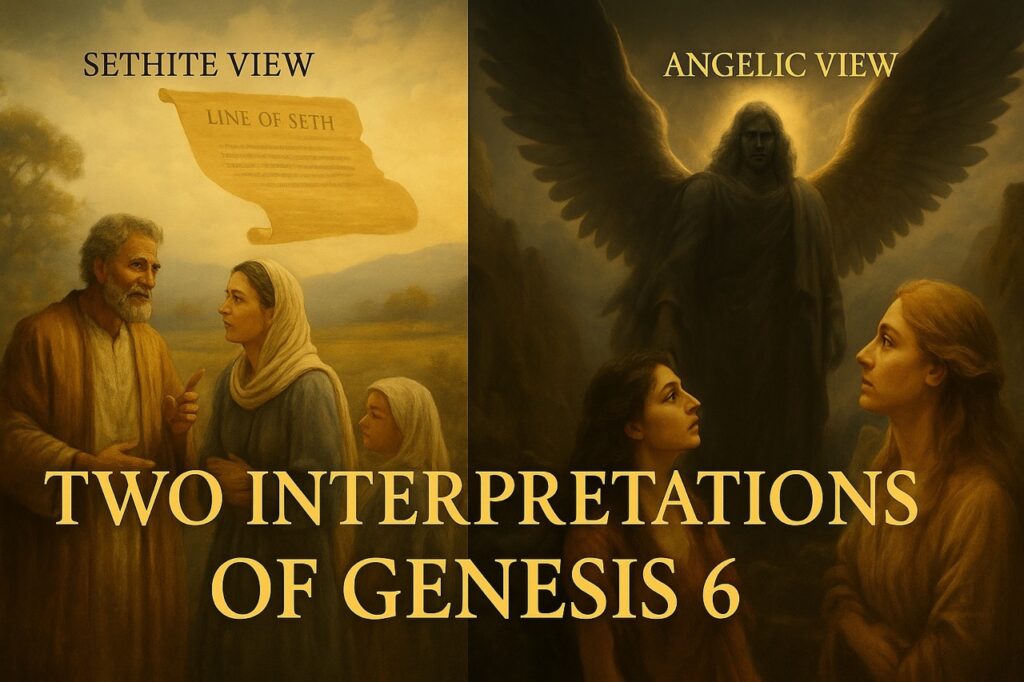
🧠 Two Main Interpretations: Sethites vs. Angels
Genesis 6:2 has sparked centuries of debate over the identity of the “sons of God” and the “daughters of men.” Two dominant views emerged throughout Jewish and Christian history — but only one aligns with the plain meaning of the Hebrew text and the oldest theological traditions.
🔹 1. The Sethite View (Human Lineage Theory)
This later interpretation suggests that the “sons of God” were godly male descendants of Seth, and that the “daughters of men” were ungodly female descendants of Cain. According to this theory, Genesis 6 is simply describing the intermarriage of two human bloodlines — the righteous with the unrighteous.
🧩 Core claims:
- Sons of God = Seth’s line
- Daughters of men = Cain’s line
- The “sin” was moral compromise or “unequally yoked” marriages
- The Nephilim are explained away as violent warriors or figurative giants
🚫 Problems with this view:
- ❌ The term bene ha’elohim is never used in the Old Testament to refer to humans — only divine beings (see Job 1:6, 2:1, 38:7)
- ❌ It fails to explain why such unions would result in giant hybrid offspring or trigger God’s judgment on all creation
- ❌ It arose later in church history, particularly with Augustine, as theological discomfort with angelic beings interacting physically with humans grew
- ❌ It appears more like a rationalization than a natural reading of the text
Despite its popularity in modern circles, the Sethite theory is historically and linguistically weak.
🔹 2. The Angelic View (Ancient and Traditional)
This older and more widely accepted view holds that the “sons of God” were fallen angels — spiritual beings who left their heavenly domain, took human women as wives, and fathered hybrid offspring known as the Nephilim.
📖 Supported by:
- Second Temple Jewish literature (like Enoch, Jubilees, and the Dead Sea Scrolls)
- The Septuagint, the ancient Greek translation of the Old Testament, renders “sons of God” as “angels of God”
- Early Church Fathers such as Justin Martyr, Irenaeus, Athenagoras, Clement of Alexandria, and Tertullian
- Josephus, the first-century Jewish historian, who wrote that angels sinned with women and begot giants (Antiquities 1.3.1)
🔥 Why it matters:
This interpretation explains:
- The sudden appearance of the Nephilim (giants of renown)
- The connection to divine rebellion
- God’s swift judgment via the Flood
- Why New Testament passages (like Jude and 2 Peter) describe angels being imprisoned in a special place called Tartarus
The angelic view is also consistent with the Book of Enoch, which offers a fuller narrative of the angelic fall — and was once widely read and quoted by early Jews and Christians alike.
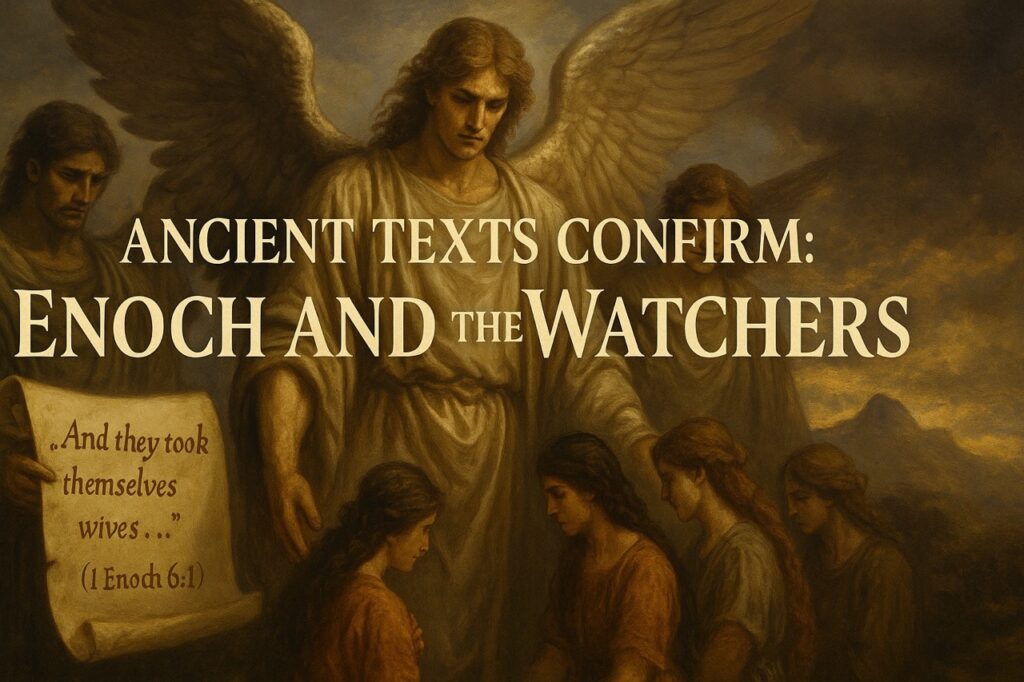
📖 Ancient Texts Confirm: Enoch and the Watchers
One of the most detailed extra-biblical sources affirming the angelic interpretation is the Book of 1 Enoch. Though not part of the modern Protestant canon, it was included in early church libraries, quoted in Jude, and respected in Ethiopian and early Jewish communities.
1 Enoch 6:1–2:
“And it came to pass… that the sons of heaven saw them and desired them. And they said to one another, ‘Come, let us choose wives from among the children of men…’”
⚔️ Key Details from Enoch:
- 200 angels, called the Watchers, descended on Mount Hermon during the days of Jared (Genesis 5:18–20)
- Their leader was Semjaza; another, Azazel, taught humanity sorcery, warfare, metalworking, and cosmetics
- They took wives, fathered monstrous giants, and corrupted all flesh
- The giants became bloodthirsty, consuming animals, humans, and eventually one another
- The flood was sent in part to cleanse the earth of this hybrid corruption
This story, though extra-biblical, aligns strikingly with the biblical pattern: divine rebellion, hybrid offspring, spread of forbidden knowledge, and God’s judgment.
⚖️ Divine Response: Judgment of the Watchers
The Bible confirms in multiple places that angels were judged and imprisoned for a specific rebellion — a rebellion that matches Genesis 6 and Enoch’s account.
✝️ New Testament Echoes:
✅ Jude 1:6–7
“And the angels who did not stay within their own position of authority, but left their proper dwelling, he has kept in eternal chains under gloomy darkness until the judgment of the great day…”
✅ 2 Peter 2:4
“For if God did not spare angels when they sinned, but cast them into hell [Tartarus] and committed them to chains of gloomy darkness to be kept until the judgment…”
These verses speak of a unique sin — not just pride, like Satan’s rebellion, but leaving their proper domain and crossing into the physical realm.
🔍 Greek Word Study: Tartarus
- Word: ταρταρόω (tartaróō)
- Meaning: A place lower than Hades, used in Greek mythology to imprison rebellious gods or titans
- Biblical use: Only appears in 2 Peter 2:4 — describing a place where God imprisoned fallen angels
This aligns exactly with Enoch’s claim: the Watchers were not roaming spirits but bound in the Abyss, awaiting final judgment. In Revelation 9:1–11, this “Abyss” may even be unlocked temporarily in the end times.

🌐 Why This Matters: Echoes Into Our World
Genesis 6 is not just an ancient curiosity — it’s a prophetic warning.
Jesus Himself pointed back to this very chapter when describing the world at the end of the age:
“As it was in the days of Noah, so will it be at the coming of the Son of Man.”
(Matthew 24:37)
This statement should cause us to pause.
What exactly were the “Days of Noah” — and why did Jesus say they would return?
⚠️ Defining the Days of Noah
When we read Genesis 6, we find not just generic sin or violence, but something unprecedented and unnatural:
- 🕊 Spiritual Rebellion — Divine beings crossing into the physical realm
- 🧬 Genetic Corruption — The mixing of angelic and human DNA through the Nephilim
- 🦍 Rise of Hybrid Giants — Physically dominant, violent, possibly immortal beings
- 🧙♂️ Forbidden Knowledge — Sorcery, weaponry, cosmetics, astrology — the Watchers taught humanity how to self-destruct
- 🔪 Widespread Bloodshed — The earth was “filled with violence” (Genesis 6:11)
These weren’t just sins — they were invasions of divine order. Creation itself was being altered.
🧠 Modern Parallels to Genesis 6
In the 21st century, we’re witnessing technologies and ideologies that mirror the very conditions described in Genesis:
🔬 Genetic Engineering & CRISPR
- Human-animal hybrids
- Gene-editing embryos
- Playing god with DNA
🛸 Alien Obsession & Abduction Phenomena
- Stories of hybrid offspring, medical experiments, and interdimensional contact
- Growing belief that “aliens” are ancient visitors or creators
🤖 Transhumanism & Posthuman Dreams
- Merging man and machine
- Uploading consciousness
- Seeking eternal life through technology — a false Tree of Life
📡 Occult Revival
- Ancient rituals, channeling spirits, New Age doctrines
- Spiritual experiences marketed as wellness, energy healing, or contact with “higher beings”
These aren’t just cultural fads — they may be echoes of ancient deception returning in a digital disguise.
🚨 What Began in Genesis 6 May Be Repeating
Just as the Watchers sought to corrupt humanity’s image, we now see increasing efforts to remake mankind in a new image — one without God.
The serpent’s old promise has returned with a Silicon Valley twist:
“You will be like gods…” — now written in code, AI, and biotech patents.
The flood was sent to halt that corruption.
What will God do this time?
📣 Reflection & Call to Action
If Jesus warned that the world would become like Noah’s day, then Genesis 6 is no longer just a backstory — it’s a roadmap. A sign. A warning. And a wake-up call.
👉 Are we ready?
👉 Do we recognize the spiritual battle beneath the technological sheen?
👉 Are we walking with God like Noah — or being swept up by the deception?
📚 Internal Reading List: Dive Deeper Into the Days of Noah
Want to explore more about the Nephilim, the Watchers, and the strange days before the Flood? Start here:
🔹 Who Were the Nephilim?
The original giants of Genesis 6 — and what Scripture and ancient texts really say about them.
🔹 Genesis 6 Explained
A verse-by-verse breakdown of the most haunting chapter in early Genesis.
🔹 Ezekiel’s Wheels and UAPs
Do modern UFOs connect to ancient spiritual realities? Exploring divine chariots, fallen tech, and deception.
📚 External Reading: Explore Further
- Who Were the Sons of God and Daughters of Men in Genesis 6:1–4?
An in-depth analysis of the various interpretations of this enigmatic passage.
Read more - The Benei Elohim, the Watchers, and the Origins of Evil
Examines how ancient texts expand upon Genesis 6, detailing the role of divine beings in human affairs.
Read more - Who Are the Sons of God in Genesis 6?
A theological perspective on the identity of the “sons of God” and their implications.
Read more - Watcher (Angel)
An overview of the Watchers as depicted in various religious texts, including their descent and actions.
Read more - Book of Enoch
Provides context on the Book of Enoch, its history, and its influence on interpretations of Genesis 6.
Read more
❓ FAQ: Long-Tail SEO Question Block
🔹 Who Were the Sons of God in Genesis 6?
The sons of God in Genesis 6:2 are best understood as divine beings, most likely fallen angels. The Hebrew phrase used is bene ha’elohim, which appears elsewhere in the Old Testament only in contexts referring to the heavenly host (Job 1:6; 2:1; 38:7). Ancient Jewish writings, such as 1 Enoch and Jubilees, as well as the Septuagint (Greek OT), consistently interpret them as angelic beings.
Early Christian theologians — including Justin Martyr, Irenaeus, and Clement of Alexandria — affirmed this interpretation. These beings left their appointed heavenly roles and took human women as wives, which triggered divine judgment.
🔹 What Is the Meaning of “Daughters of Men” in Genesis 6?
The daughters of men refer to mortal human women — likely descended from the general population of humanity. This phrase does not denote a specific lineage (e.g., Cain’s line), as some modern interpretations suggest. Instead, it serves to emphasize the earthly, flesh-bound nature of the women, contrasted with the spiritual nature of the sons of God.
The union of the spiritual with the fleshly — a violation of God’s created order — is what sets this story apart from any normal moral failing. It led to the birth of the Nephilim, who became mighty and violent giants on the earth.
🔹 What Does the Book of Enoch Say About the Sons of God?
The Book of 1 Enoch, an ancient Jewish text referenced in Jude 1:14–15, provides an expanded narrative of Genesis 6. It identifies the sons of God as a group of 200 angels known as the Watchers who descended on Mount Hermon in the days of Jared.
Key teachings from 1 Enoch:
- These angels took human wives and defiled themselves
- Their leader was Semjaza, and Azazel taught forbidden knowledge (weaponry, sorcery, cosmetics, astrology)
- Their offspring were giants, or Nephilim, who eventually turned violent, devouring humanity
- God judged the Watchers by imprisoning them in Tartarus until the Day of Judgment
Though not part of the Protestant canon, 1 Enoch was widely read in Second Temple Judaism, included in the Ethiopian Orthodox Bible, and preserved among the Dead Sea Scrolls.
🔹 Is the Angelic View of Genesis 6 Heretical?
No — in fact, the angelic interpretation was the dominant view in both Jewish and early Christian thought for centuries. The shift away from this interpretation didn’t begin until the writings of Augustine (4th–5th century AD), who promoted the Sethite view for philosophical and theological reasons.
The angelic view is supported by:
- The Hebrew grammar of bene ha’elohim
- The context of other Old Testament texts (e.g., Job)
- The Book of Enoch and other ancient writings
- New Testament passages such as Jude 1:6 and 2 Peter 2:4
Far from heretical, this view was historically orthodox, even if unsettling.
🔹 Does Genesis 6 Connect to Modern UFOs or Alien Theories?
Many researchers and theologians believe there may be spiritual deception behind modern alien narratives. According to this theory, modern reports of alien abductions, hybridization experiments, and contact with higher intelligences could echo the ancient story of the Watchers.
- Like the Watchers, these so-called “aliens” tamper with genetics
- Like the Nephilim, hybrid children are often reported in abductee accounts
- The phenomenon often includes occult elements, not just physical experiences
Some suggest the return of the Watchers might be disguised through the UFO phenomenon — creating confusion in the last days by blending spiritual rebellion with modern science fiction. If true, it would fulfill Jesus’ warning that the “days of Noah” would return before His coming (Matthew 24:37).

